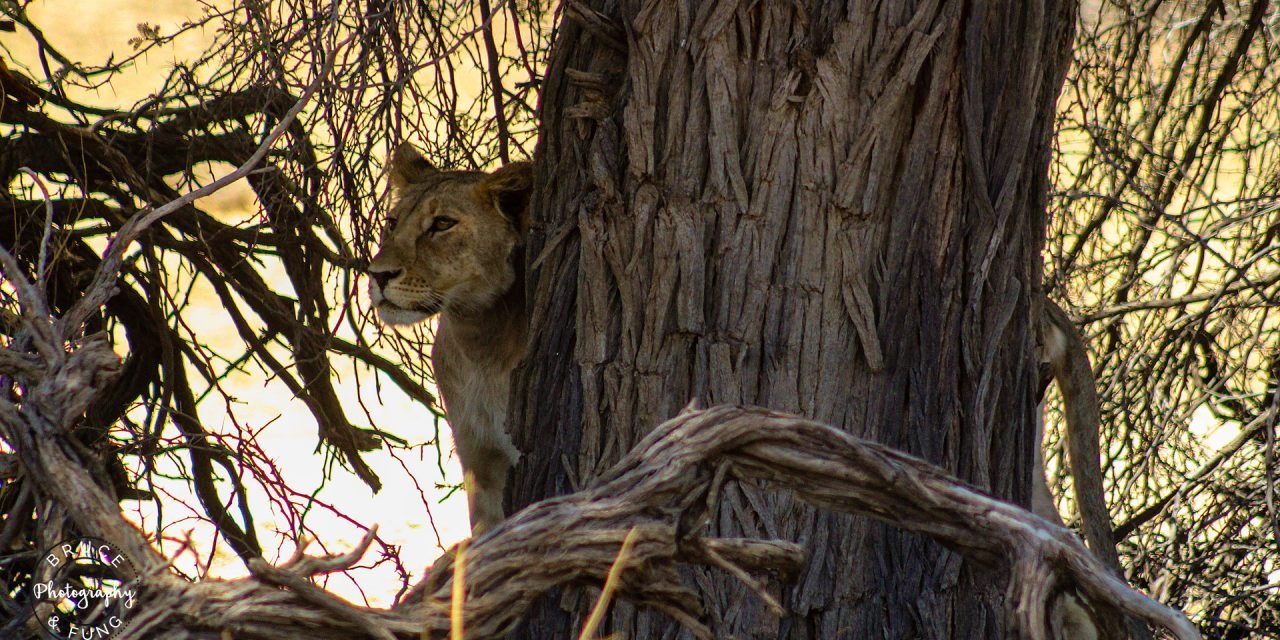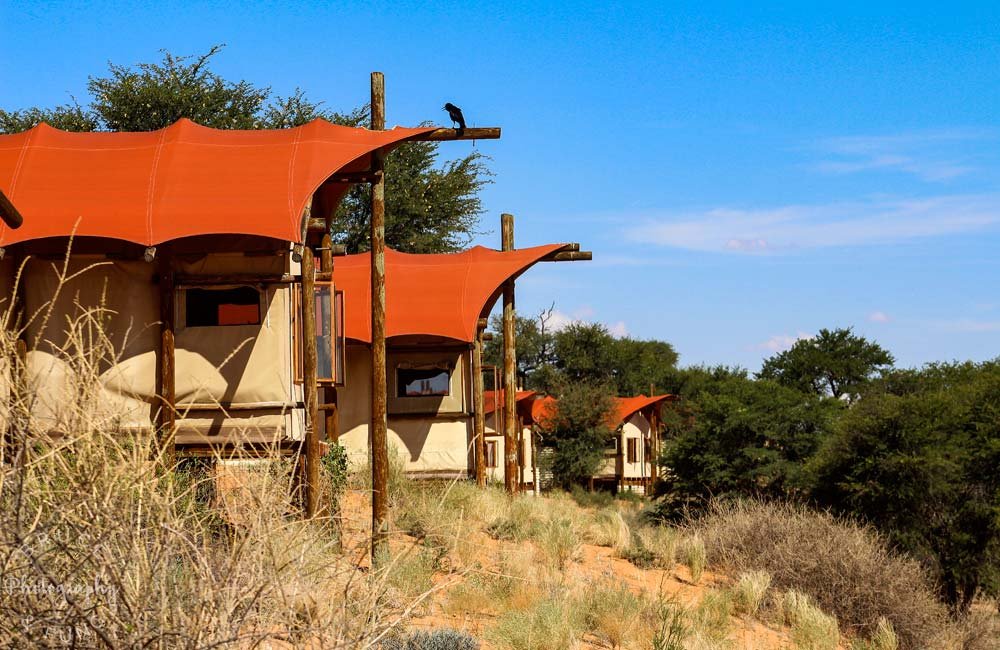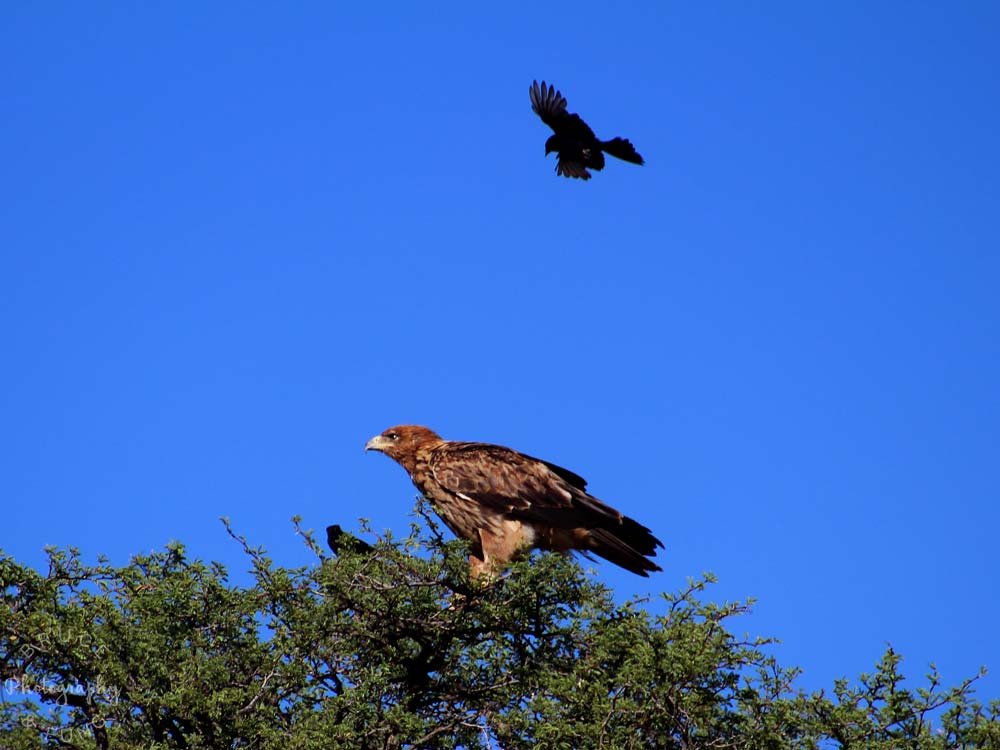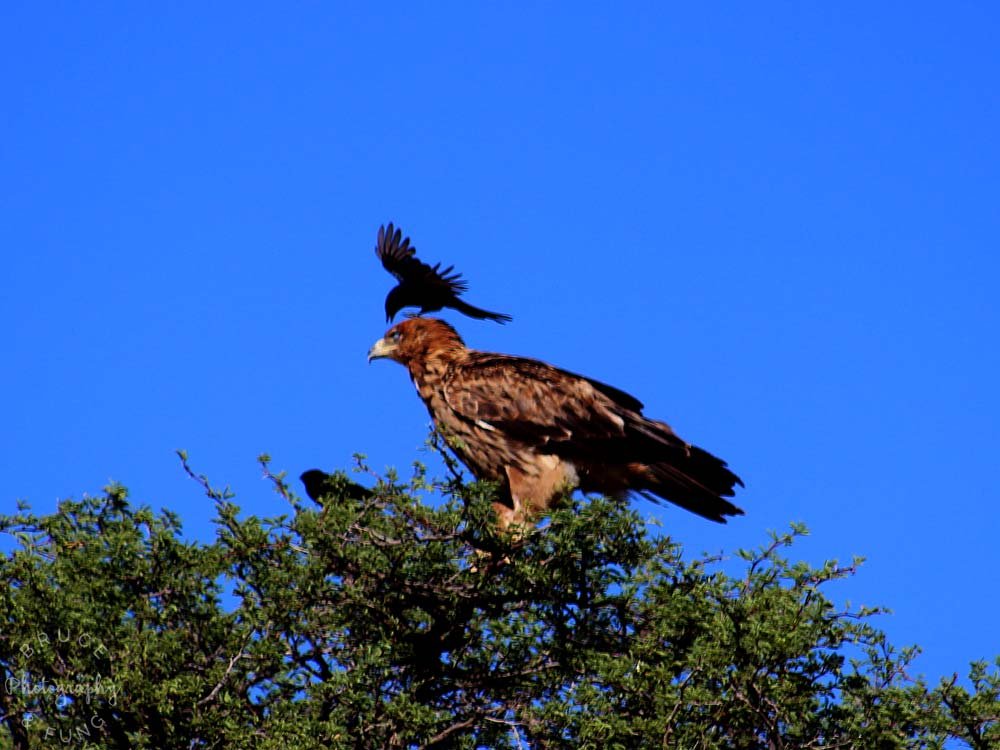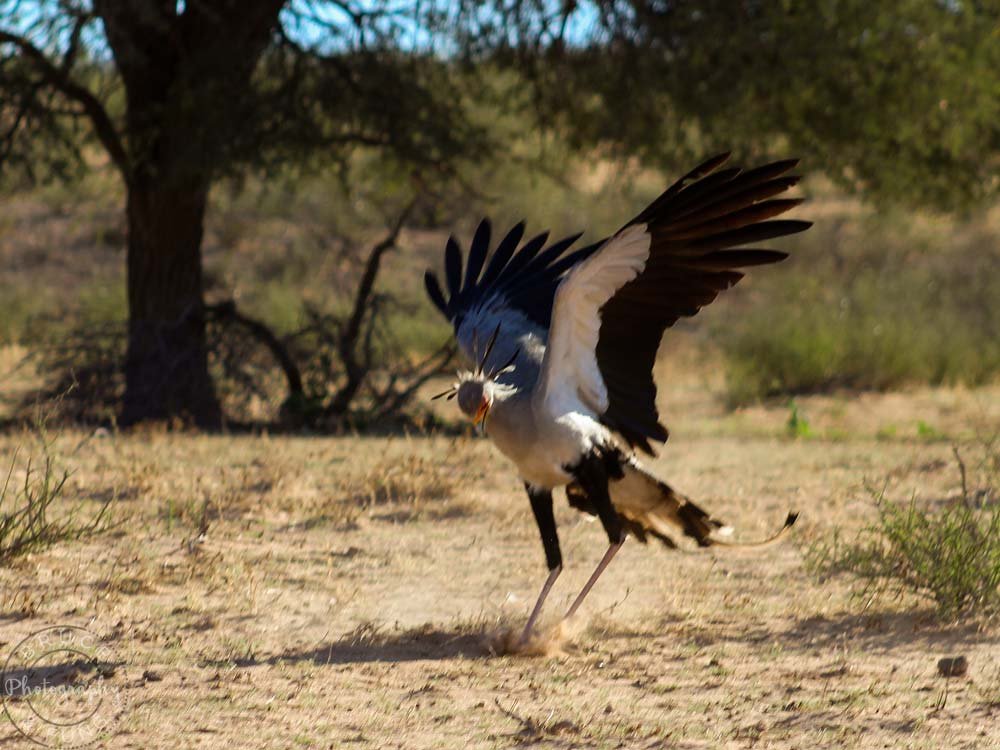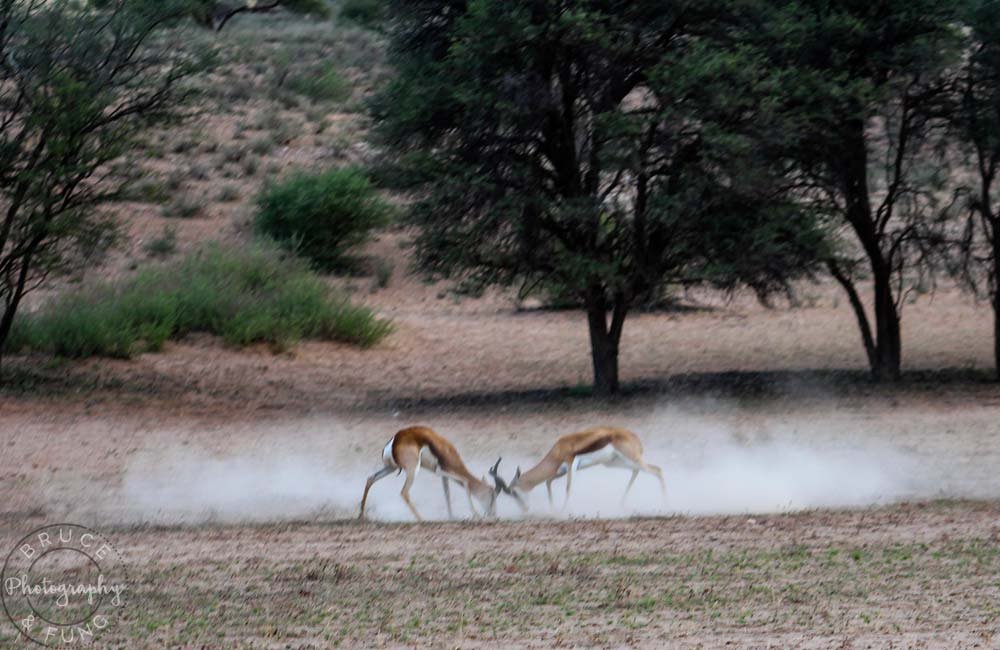KGALAGADI PT. 2:KALAHARI DREAMING
We had first heard of the Kgalagadi Transfrontier Park (KTP) from South African friends many years ago. They told us in reverential tones about this amazing park in the Kalahari Desert that we just had to visit since it offered a wildlife experience of a lifetime. Yes, Kruger Park was the crown jewel of the South African park system. It had great infrastructure, was fantastic for wildlife and easy to “do”. But Kgalagadi offered a more exclusive and unique experience that would be truly exceptional. A wide variety of predators combined with incredible landscapes beckoned. We were intrigued, so looked into the possibilities.
Being a desert environment, we knew that temperatures can be extreme, even within the same day. We learned that KTP summer daily highs are well over 40° C (104°F) while winter nighttime lows can reach -11°C (14°F). Our only windows of travel possibilities at that time were during school holidays, which limited our options considerably. We would rather bake than freeze, so we chose to visit Kgalagadi over the Christmas break.
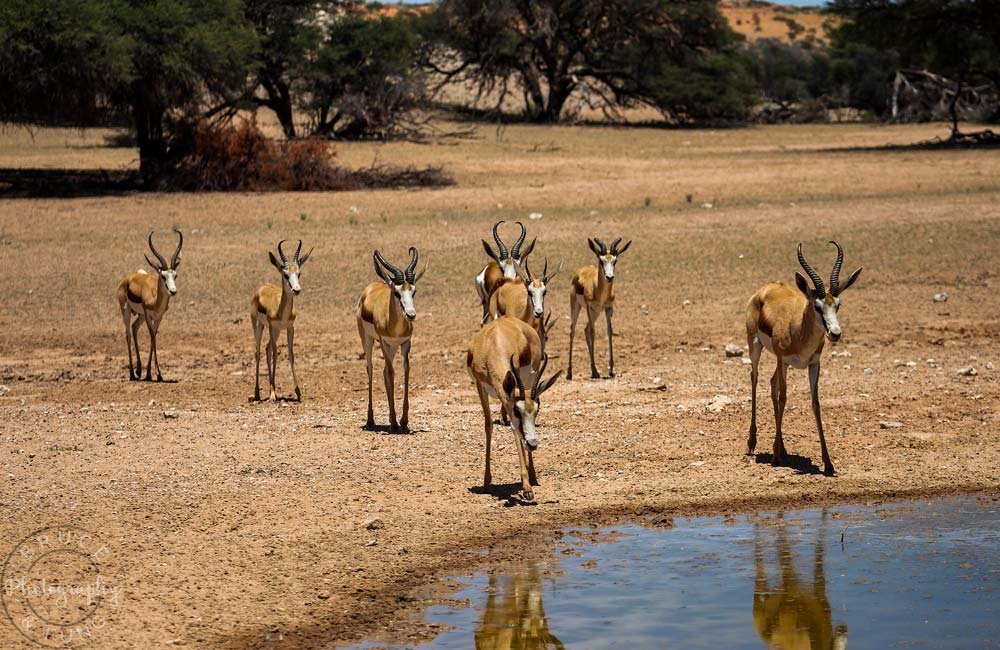
Above: Springbok approaching the Dalkeith waterhole in the upper Auob riverbed. Notice the variations in their horns. Top: A young lion behind a leadwood tree. This dense, slow-burning wood sinks in water and the tree stays upright long after it dies.
THE PLAN COMES TOGETHER
So on our second trip to South Africa, we were finally set for our long-awaited trip to Kgalagadi. Our plan was to drive up to the KTP from Cape Town before heading east to visit three other parks: Mokala, Golden Gate Highlands and finish off with a return to Kruger. We would eventually drop our rented car off at the Johannesburg airport and fly home, spending a month on our cross-country road trip.
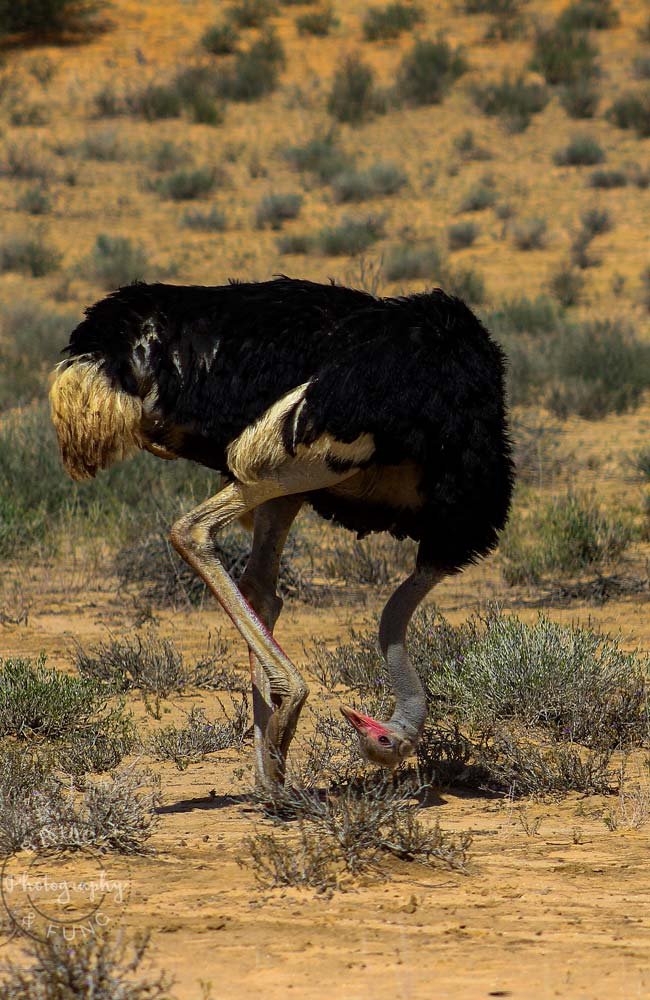
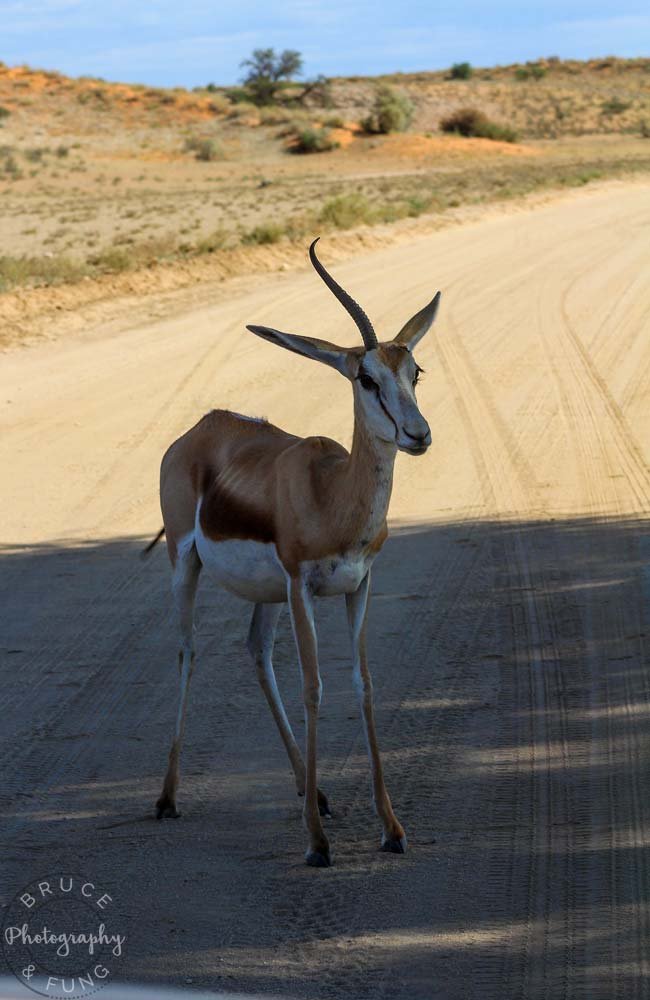
Above left: Ostriches are always doing strange things. Above right: While on the subject of strange, a pregnant Kgalagadi unicorn (a one-horned springbok). Both pictures were taken on the lower Nossob road.
HEADING TO THE HORIZON
Leaving Cape Town, we had an air of expectation as we drove through South Africa’s least-populated area, the Great Karoo. We were aimed north-north-east to Keimoes (just outside Upington), determined to get to our distant destination before sunset. We zoomed along the immaculate blacktop road, for the most part straight to the flat, featureless horizon. There were very few topographic features and almost no trees at all. Still, it was impressive, just for the barren emptiness.
Another car would be encountered only every hour or so once we left the primary north-south road that continues to Namibia. Even though our car was comfortably cruising well over the speed limit, pretty much every car going our way blew past us as if we were Sunday drivers. Passing the isolated communities of Calvinia, Brandvlei and Kenhardt, we watched the sun sink inexorably toward the horizon and reached our accommodation with a thankful sigh just after sunset.
THE OVERLOOK
After settling in we enjoyed a perfectly-cooked steak dinner brought to our bungalow by Eric, the American Chef who runs The Overlook with his South African wife. The huge South African portions are always a problem for us. None of us could even make half of what was on our plate disappear. Our bungalow was atop a hill overlooking vineyards along the Orange River in what is called “The Green Kalahari”. Everything was clean and comfortable, but we were there only for the night.
The next morning we drove 20 minutes into Upington to stock up at the Pick n’Pay there, augmenting what we brought from Cape Town (including bags of cherries that we picked ourselves in orchards near Ceres). Then we hit the road for the 2.5 hours of driving to reach the Twee Rivieren KTP entrance. Our excitement built as we entered the Kalahari proper. We passed salt pans amidst the undulating red dunes and soon found ourselves at the gateway to Kgalagadi.

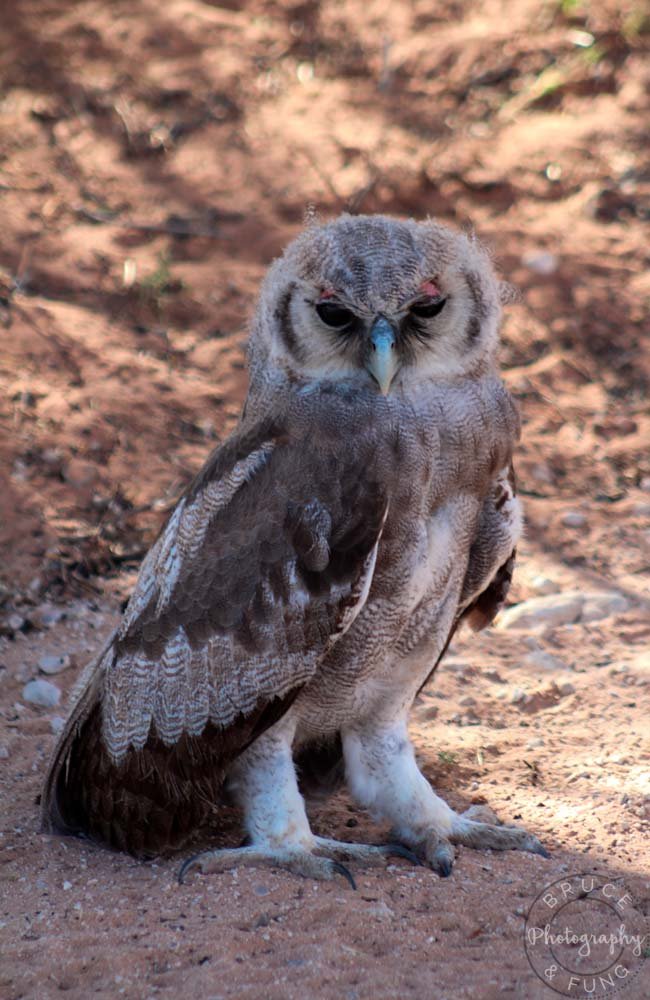
Above left: a red-crested korhaan. We love the yellow eyes. Above right: a sleepy juvenile Verreaux’s eagle owl.
Click here for the official SANParks Kgalagadi map which shows all the roads, camps, and waterholes. This will allow you to follow along on our trip. Reading our Kgalagadi Guide will also help to better understand this post.
AN AUSPICIOUS START
After entering Kgalagadi at Twee Rivieren we started up the Auob road, not expecting to see much since it was early afternoon. One of the first creatures we encountered was a young Verreaux’s (Giant) eagle owl sitting on the side of the road. We later learned that the young often do this, while one of the parents may be seen in the tree above, keeping watch. We did not see an adult, though we didn’t really look closely.
Soon after, we pulled up to a car stopped at the side of the road. The occupants pointed up to a small cave in the calcrete cliff where a leopard was gazing down at us. We could see it with binoculars, but it was too distant to photograph and we assumed that we’d see more. A little further up the road we saw an African wildcat in a fallen tree (once more pointed out by another car). Sadly, they were the only ones we saw, failing to spot either species again during our stay. It was a good start though.
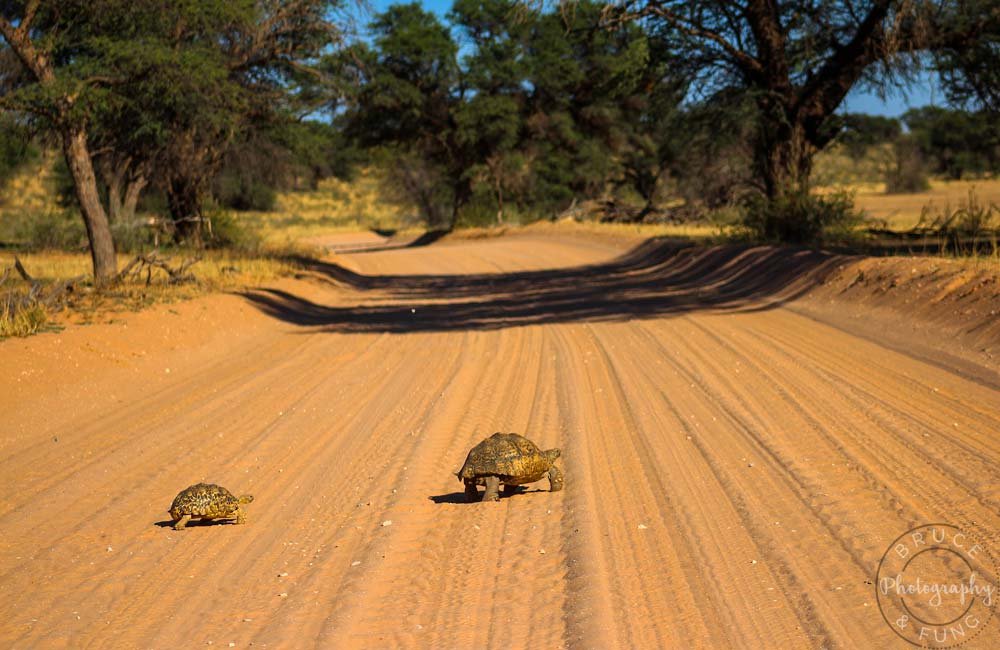
Top: A pair of leopard tortoises crossing the Auob road. We would see a few of these daily. In this case we watched as the large one clambered up the opposite slope, but the smaller one kept sliding back down in the soft sand. It seemed determined, but we moved on after it failed several attempts and do not know if it finally succeeded. Above left: Our unit at the Kalahari Tented Camp. Above right: The neighbors, with a crow keeping watch.
GLAMPING AT THE KTC
Our first few nights were spent staying at the Kalahari Tented Camp, just 3 km south of the Namibian border post at Mata Mata. Our family desert tent consisted of a large permanent tent with frames on the windows and beams strengthening the canvas tenting. There were four single beds on a wooden floor and some sandbag fortification with a spacious attached bathroom.
Like all of the six wilderness camps in Kgalagadi, this camp uses solar power for lights and a ceiling fan, with gas powering the water heater (for the shower), the fridge and the stove. The kitchen was in a second, more fortified building. Everything was strongly-constructed, clean and well thought-out. Having solar power meant that our ceiling fan and lights were operational all night, which was a welcome bonus (in two of the three main camps, power is shut off every night from 21:30 – 05:00). We used the obligatory braai (bbq) unit on our terrace for cooking every evening while marvelling at the fiery desert sunsets and watching for activity at the distant waterhole in the Auob river bed. At ~150 meters away, it was too far for pictures, but we still kept an eye out for visitors. During our time there the waterhole wasn’t very productive and we saw only a few wildebeest, springbok, jackals and hyenas stop for a drink.

The view from our tent towards the small waterhole – a puddle, really – just beyond the scraggly little tree near the far side of the riverbed. Not much to see…
It was extremely hot by day, but sleeping was comfortable when the temperatures dipped at night to more tolerable levels. On one night we were subjected to a fierce wind storm that hammered at our tent for hours. We suffered no damage, but the neighbouring unit had canvas strips torn off of it which made quite a racket, whipping in the wind. Later we learned that these windy nights are actually fairly common at that time of the year.

A majestic lioness at the Dertiende Boorgat waterhole in the Auob riverbed.
ROARS IN THE NIGHT
On our first night we were woken by roaring lions, which is one of the most thrilling African night time sounds. You can feel the power of the roars if they are close by. The roars kept getting louder and eventually we came to the realization that a pride was actually walking straight towards us! They eventually strolled right past our tent, within 3 meters from our pillows. It was all very exciting (though Fung may use a slightly different adjective) and a great introduction to the park.
They came by the next night as well, but we never actually laid eyes on them, seeing only their footprints in the sand the next morning. Much more obvious was a curious yellow mongoose that would check us out from time to time, but vanish as soon as a camera was brought out. Plentiful ground squirrels were also in attendance around the camp.
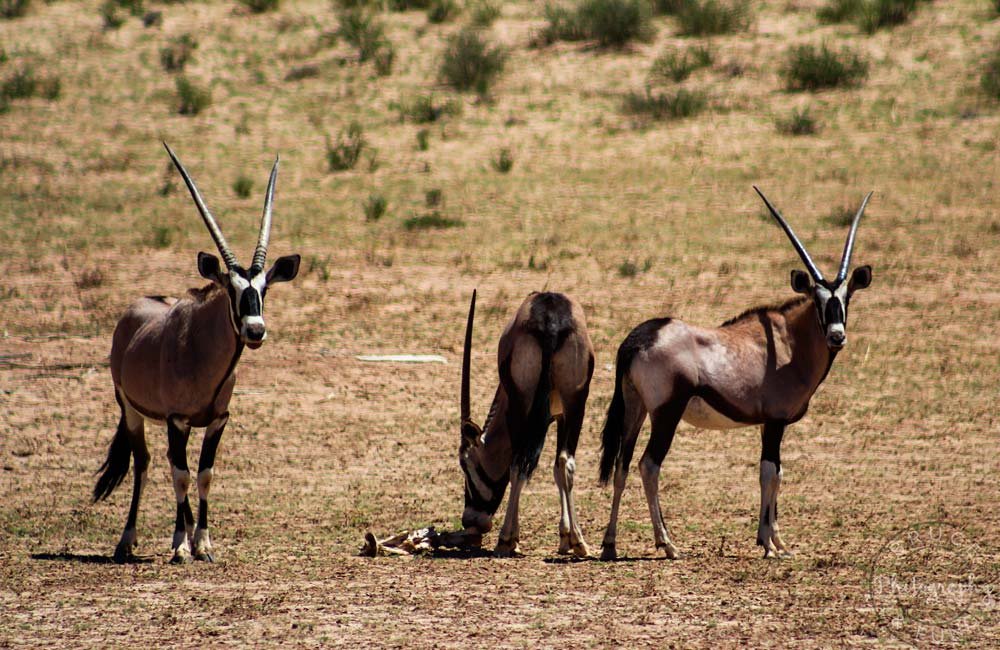
Gemsbok at the Craig Lockhart waterhole near Mata Mata. Do they lick bones for calcium? Or is this one nibbling bits of hardened old cartilage left by scavengers?
THIS IS HOW YOU DO IT
Game viewing from this camp is simple. You have no choice but to head south, spending time parked at any of the waterholes that are arranged along the riverbed, spaced less than 10 km apart. This is the way to go since the animals tend to be near the water, with the game coming to you if you are patient. We covered no more than five waterholes in each twice-daily out-and-back game drives, depending on what was there and what sort of feeling of potential we had (and if there was a tree to park under, which there usually was). We saw other cars from time to time, but rarely shared a waterhole with even a single other car, even though it was the holiday season.

Top: These forktail drongos were determined to run off the much-bigger tawny eagle and after a few attacks they succeeded. Bottom: Springbok and wildebeest sharing shade at the Craig Lockhart waterhole. This picture was taken ~6 pm, but it was still too hot for them to consider venturing out.
AUOB ENCOUNTERS
We saw cheetahs and lions every day. Another charismatic species we encountered were the giraffe around the same waterhole every time we visited, munching on the trees. They were reintroduced to the park after being previously hunted out. Once released from their acclimatization enclosure, they have kept to the same area, even a few generations later.
Herds of springbok, wildebeest and gemsbok were plentiful. Jackals and ostrich were also common, as throughout the park. We found a den of bat-eared foxes, watched a hunting secretary bird and were very impressed by the numbers and variety of raptors in the trees. Falcons and goshawks could be seen swooping down to hunt Burchell’s and Namaqua sandgrouse as well as Cape turtle doves that drank at waterholes in the morning (each species in a different time slot). Even though we were re-visiting the same waterholes every day a number of times, we were never bored.


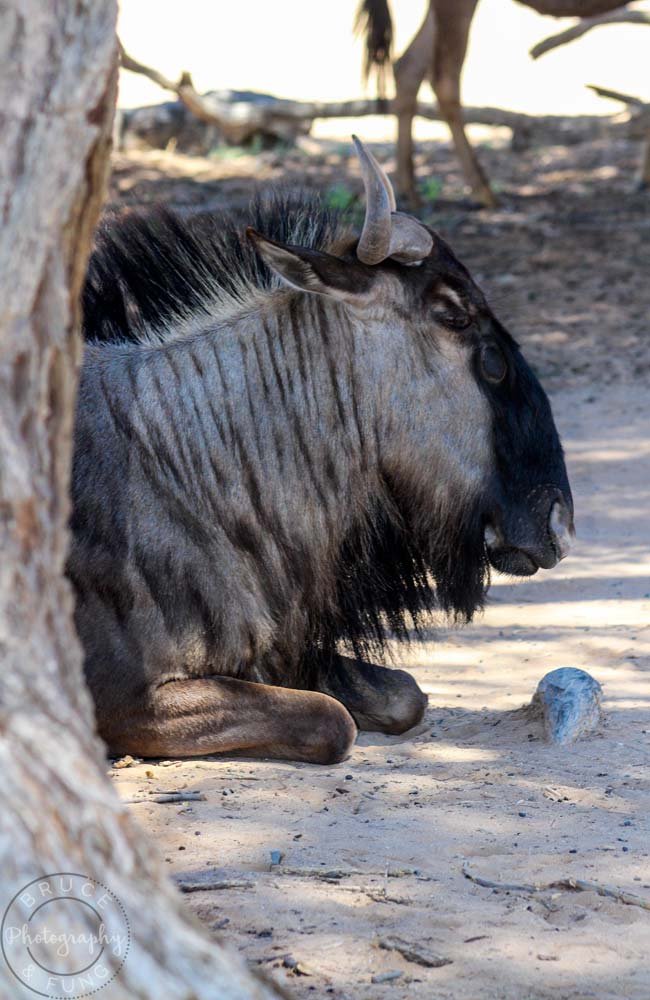
Top: A hunting secretary bird, first stomping on prey and then eating it. We could not identify what it is swallowing in the second photo. They normally prefer snakes and lizards. Middle: a fresh newborn springbok, keeping still while it gathers strength with the mother keeping watch from a distance in order not to attract attention. Still, jackals and cheetah make off with many before they can see their first sunset. Bottom left: a springbok enjoying a drink . Bottom right: A relaxing blue wildebeest at Craig Lockhart.
ACROSS THE DUNES TO NOSSOB
For our next stop we crossed over the endless sand dunes on what is called the Upper Dune Road. This was around 55 km of undulating gravel road,… up and down, up and down,.. but fun. One must take care on the crest of each dune to keep to the side of the road as it seemed to us that head-on collisions would be a danger with drivers lulled by the roller-coaster rhythm of the road. But we cannot recall ever seeing another car during our crossing.
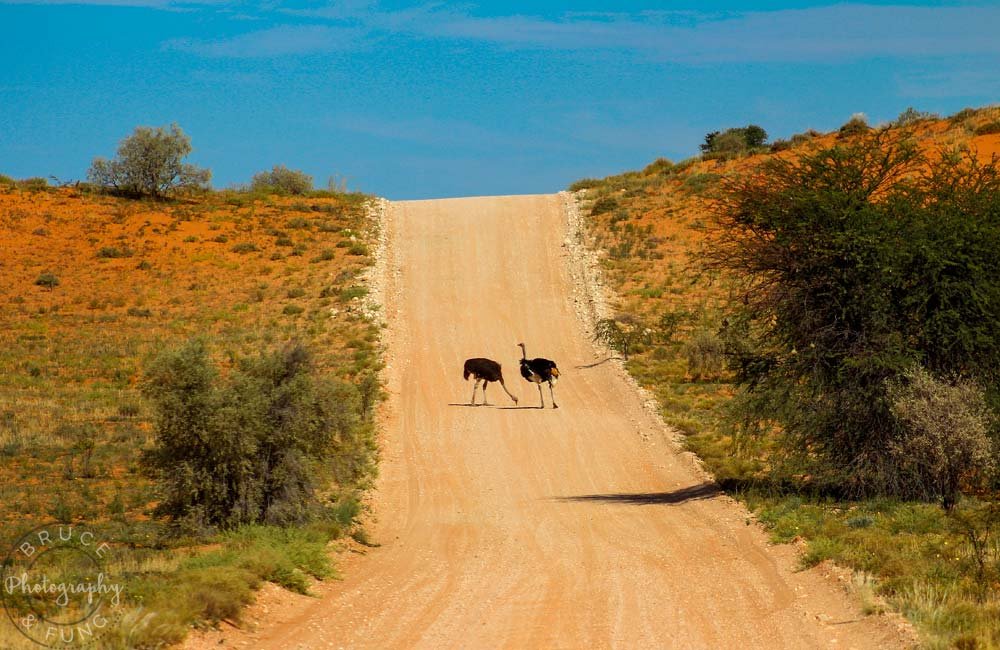
An ostrich pair sampling gravel on one of the Dune Roads.
There was obviously rain the previous night as the desert was suddenly ablaze with yellow and purple from blooming flowers that erupt immediately after any rainfall. Once we joined the main Nossob road there was quite a bit of standing water in the riverbed, so it must have been quite a downpour. Sections of the Auob and Nossob run only every century or so after exceptionally heavy rains. The Auob last flowed in 1973 and 1974, while the Nossob flowed in 1964. Still, care must be taken in the rainy season as roads can turn muddy and be closed, especially the lower Nossob road. That is when a 4×4 is very useful.

A temporary waterhole in the Nossob riverbed, newly-formed after a downpour. Gemsbok are plentiful all over Kgalagadi, but we only saw red hartebeest on the Nossob side.
Our second camp was the famous Nossob Camp. Lion Country! We really liked our chalet. It had a new microwave and fridge. It was spacious, with a proper bed for Max instead of the usual fold-out sleeper couch found in many park chalets. Also, because the power was from a generator, we had a toaster along with the microwave as well as the ability to charge computers and camera batteries. So far, so good.
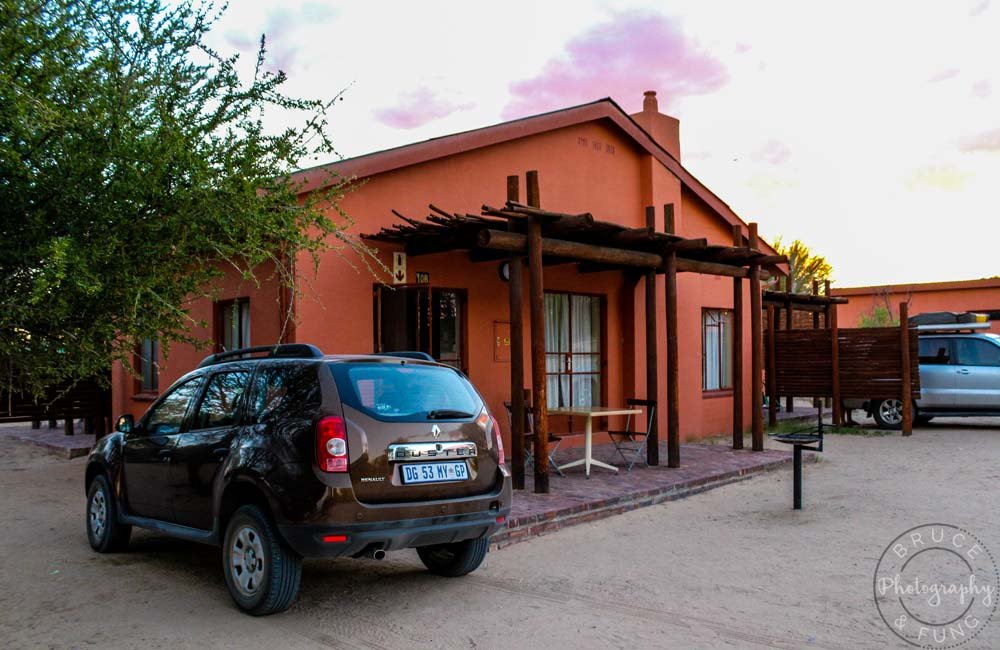
Our family chalet at Nossob Camp with our trusty Renault Duster. Notice the braai (BBQ) stand out front, which is standard issue for South African park accomodation.
LIONS!
We immediately went to check out their viewing hide, which extended from the front of the camp, reached by a protected elevated walkway. It was situated on the edge of the wide river bed with a waterhole placed in front. There were some other people already there, but nothing was to be seen in our field of view.
Then some kids motioned for us to look down. Peering between the planks that we were standing on, we immediately noticed a large female lion with a few cubs lazily gazing back at us while laid out on the sand. They were only just over a meter directly beneath us, but didn’t seem bothered, only mildly curious. The intense heat kept everything moving at a minimum and they were probably enjoying more comprehensive shade than they could hope for under any of the nearby bushes or straggly trees. The space between the planks was fine for viewing, but not enough for picture-taking, sadly.
After settling in, we headed out for a late afternoon game drive. Just outside the camp gate was a massive male lion, dozing on his back around 15 meters away, just off the road. The gates are self-serve, so Bruce opened it up, and slowly drove out enough to clear the threshold. Then, as quietly as possible, opened his door and started to tip-toe back to close the gate. The lion showed no movement and Bruce was sure that he’d be back in the car before the lion could conceivably find his feet.
Then some action did happen! But it was from a different direction as a passing park ranger inside the camp came running over, quietly but vigorously waving me back into the car while he closed the gate for us. The lion never even batted an eye. On getting closer in order to get pictures, he only opened one eye a sliver to acknowledge us before returning to his soporific siesta.

The Kalahari black-maned lions in Kgalagadi are magnificent beasts. Notice how huge his head is!
ENJOYING THE PARK ALL TO OURSELVES
On that afternoon drive we did not see a single car from leaving the camp until we returned. Even though Nossob camp is one of the three main camps, there is no other nearby accommodation, so it is a quieter area compared to the Auob side or the lower Nossob riverbed area.

A black-backed jackal looking for opportunities in the Nossob grasslands at dusk.
The Nossob is different to the Auob. While the Auob riverbed is a steep-sided valley only 100-500m wide, the Nossob is a wider, more sandy depression, with open grassland and less dunes. This results in a different sort of experience: less compact, but still plenty to see. Overall, we saw more in the Auob riverbed but it just depends on your luck at the time.
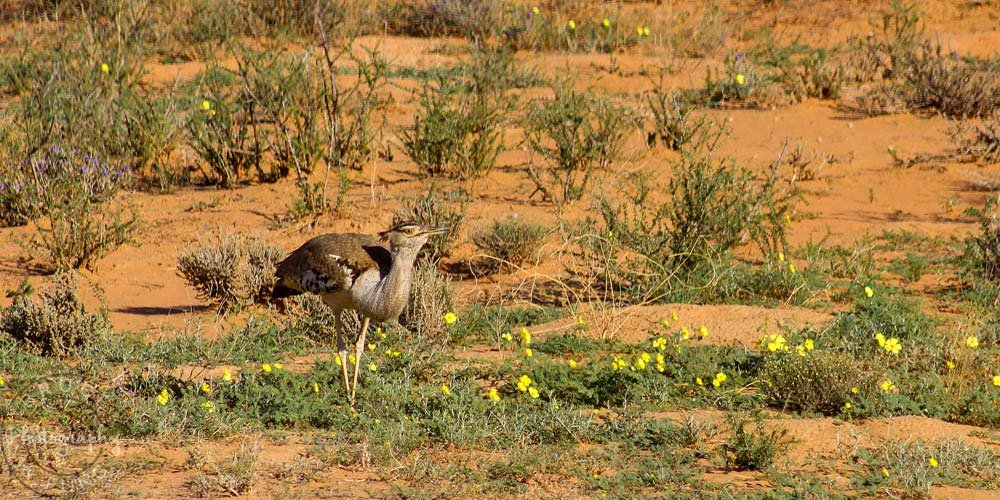

Kori bustards are common in Kgalagadi. Here’s one eating the newly-bloomed Devil’s thorn flowers along the Upper Dune Road (top) and another in the Lower Nossob area taking flight, but leaving a feather behind (bottom).
HOT ENOUGH TO BOIL A MONKEY’S BUM!
That night we revised our opinion of our chalet. At 21:30, the power was shut off, killing the lights and our precious a/c unit. We immediately heard the small windows from the other units squeaking open. Then the heat that the building had been absorbing all day was put to use turning the room into a veritable oven. Well, it wasn’t really that bad, but it was far too hot to sleep. So we sweated the night away in our room, dozing fitfully while we willed the clock to move faster towards 05:00, when the power and a/c would come back on.
The next day we chatted with some of our neighbours and the ones who were camping didn’t complain. But all those in the bungalows professed to a sleepless night. We were told not to sleep on the veranda because of scorpions and snakes, which is a reasonable request. We heard of someone who moved to their car to get a better sleep. It was simply too hot. Thankfully we only had to endure that single night at Nossob Camp.
COMFORT AT THE KGALAGADI LODGE
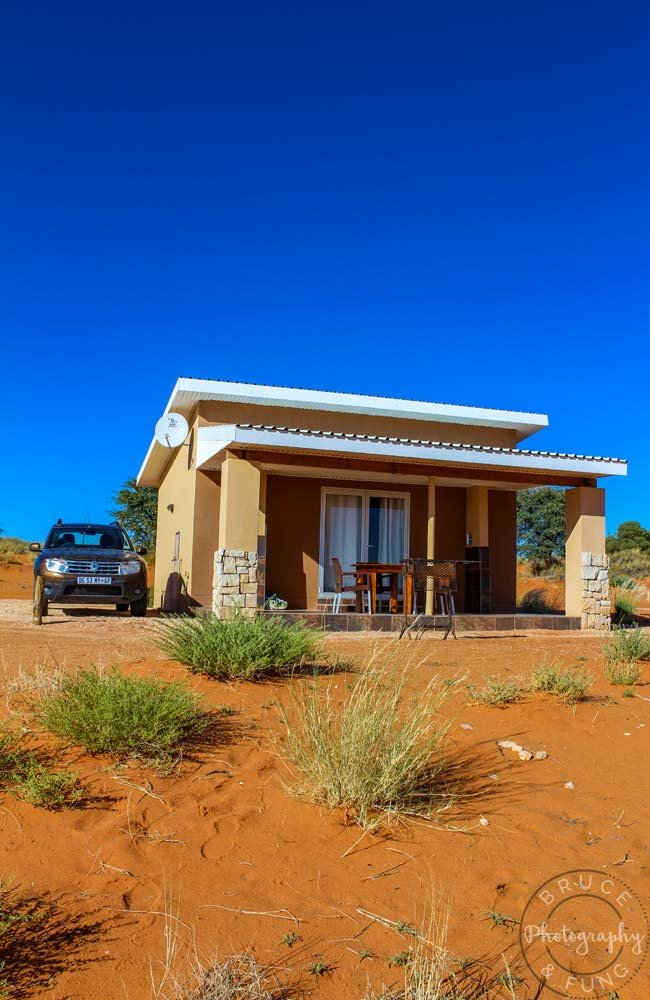
The next day was Christmas Eve and our plan was to move somewhere more comfortable for Christmas. The following four nights had us just 5 km outside the park gates at the Kgalagadi Lodge. It certainly was comfortable. We enjoyed blasting a/c around the clock, wi-fi and a well-appointed kitchen. There was a good restaurant, a pool, a shop with more fresh food than was offered in the park shops, a bakery, butchery and more. It was a relief and we were thankful to get a comfortable night of sleep. The row of units were high on a dune with an expansive vista and we could watch nightly lightning storms moving over the desert in the distance.
While exploring the dunes behind our chalet we found nests of giant millipedes in the roots of nearby trees. Also, finding scorpions at night was easy with our UV torch. This isn’t a great selling point if you don’t like creepy-crawlies, but we were fascinated. An unexpected bonus was a pair of emu that came mooching for snacks every afternoon. Yes, the large flightless Australian bird. How they ended up on a different continent was a mystery (we never asked), but they’re desert-adapted and seemed happy and healthy.

Top right: Our unit at Kgalagadi Lodge. All that was missing was a shelter to protect our car from the burning sun. Above: One of the friendly emus coming ’round for some attention and food.
EXPLORING SOUTH KGALAGADI
The only thing that we did not like was learning that though the camp gates opened at 05:30, the main gate for the park only opened at 07:00. This was a surprise that resulted in us missing the coolest part of the day for game drives. For that reason alone we would not stay there again, but as a place to stay in transit or for shopping, we highly recommend the Kgalagadi Lodge.
The Twee Rivieren Camp (Afrikaans for Two Rivers) would have been better for us, just inside the park gate, but at the time of our visit they had a resident bat problem during the hot months. The little buggers were flying around in most of the chalets on a nightly basis, burrowing through the thatch from their colonies under the eaves. The fact that they liked to live above the a/c units, which would then blow their smell into the rooms was an added negative. This would be a clear deal-breaker for us. We will not share our accomodation with bats, full stop.
Since that time, the park authorities have installed bat-proofing (mesh barriers held by cement) around the inside edge of the thatched roof to keep them outside. Bat houses have been erected as well, to encourage them to nest away from the outer eaves of the chalets. So the situation seems to have been greatly improved.
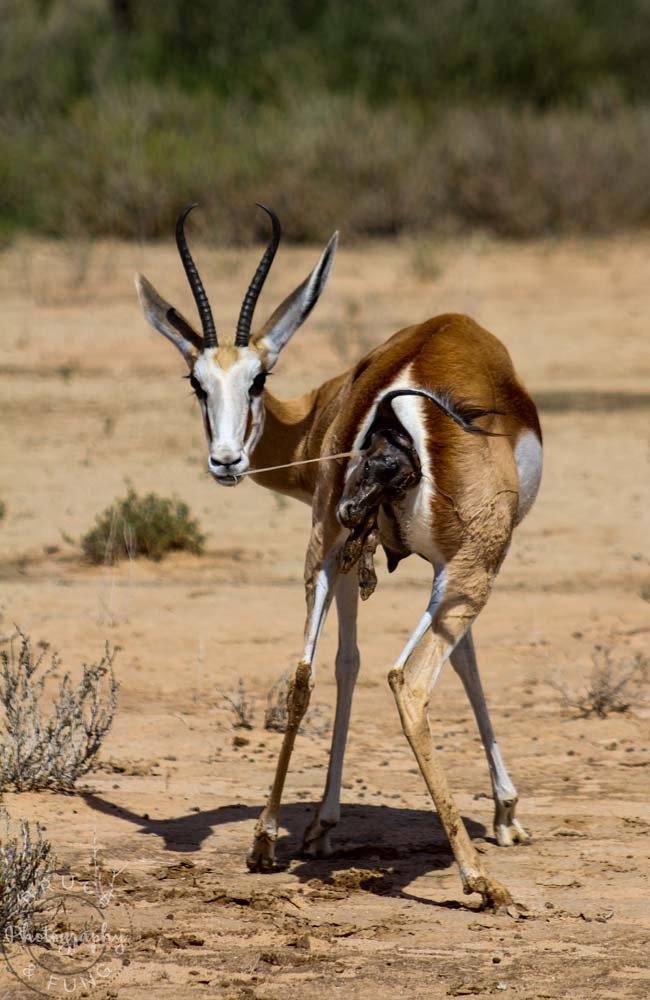
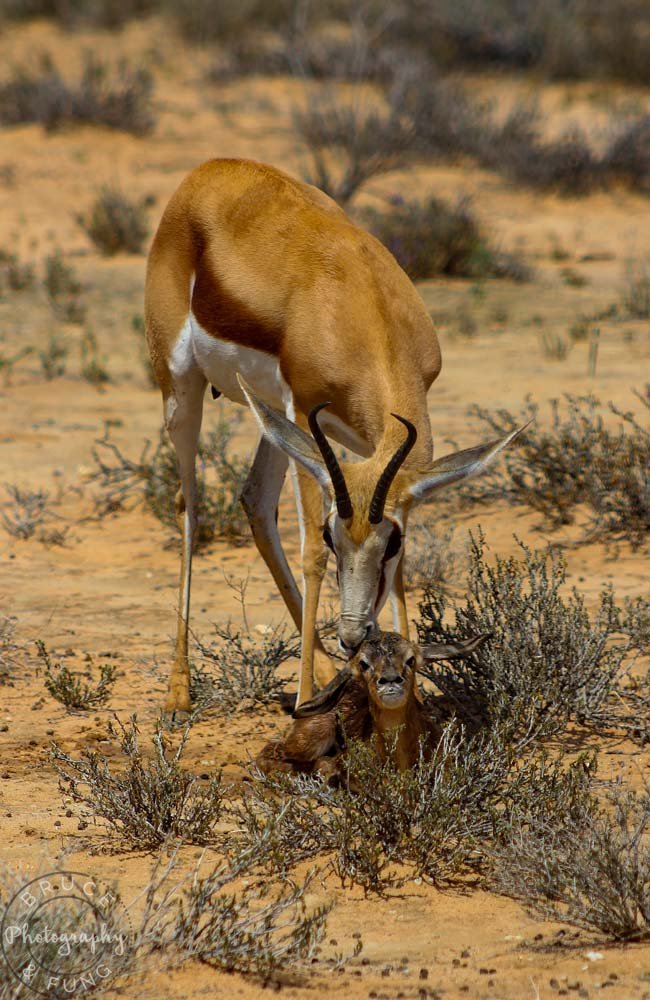
Top left: Jousting springbok near Mata Mata. Top right: A very lucky sighting. It’s a mother honey badger carrying a baby, moving to a new home under a big bush. Our lens couldn’t capture it clearly, but it was a highlight to watch. Middle: A springbok giving birth and then licking clean the newly-dropped foal. Bottom: a pale chanting goshawk (one of two) hopping along with a cape cobra, hoping to get prey disturbed by the snake. They often tag along with honey badgers as well.
SOUTHERN SIGHTINGS
Even though we couldn’t get into the park as early as we wanted, we had excellent sightings, particularly along the first five waterholes driving up the Nossob river bed. Cheetahs, lions, a honey badger carrying its young, a springbok giving birth (read here for the full story with pictures), a pair of pale chanting goshawks following a cape cobra and much more.

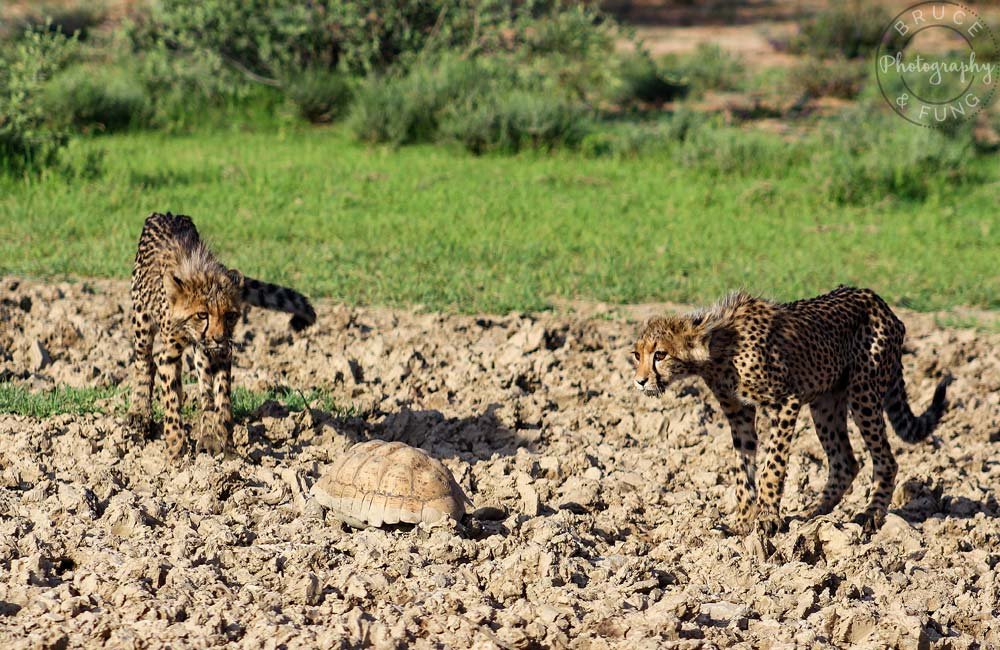
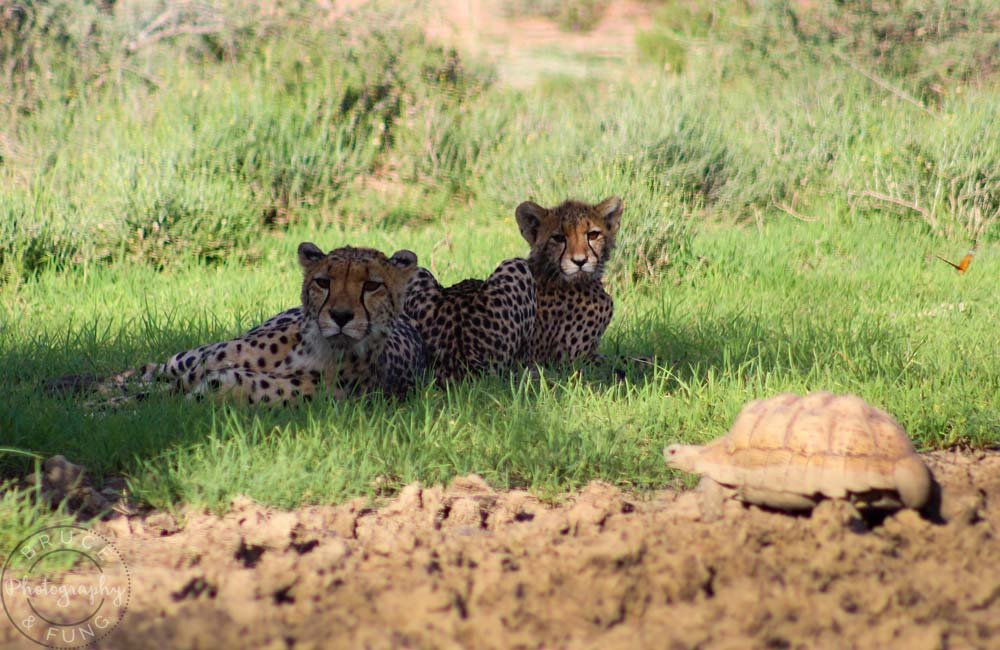

Above: A mother cheetah with cubs at the Samevloeing waterhole just north of Twee Rivieren. The youngsters were attracted to a passing tortoise, seeing it as a threat, but quickly grew bored, just keeping an eye on it as it passed.
KGALAGADI: WELL WORTH IT
In conclusion, even with scorching temperatures over 45° C (113°F) every day, we were impressed. This park is simply outstanding. If it was that productive in the most sweltering period of the year, we look forward to seeing how much better it will be during the cooler months. There were periods of driving around with little or nothing to see other than the scenery. But there was still more special encounters compared to other parks we visited. We cannot envision a better park to see large and small predators in open terrain and often at close quarters with so few other humans around.
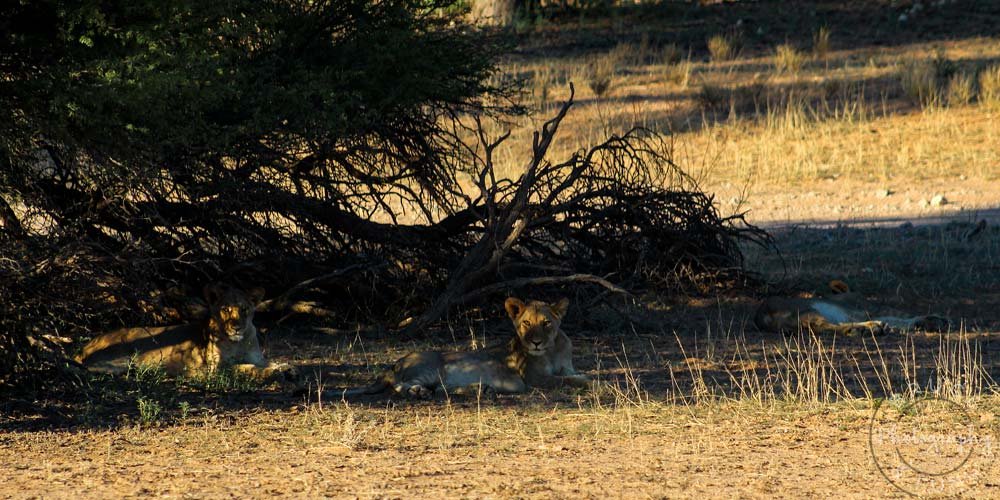
Above: Three young lions keeping to the shade in the Auob riverbed.
MORE SOUTH AFRICAN CONTENT
The Kgalagadi Transfrontier Park: Our Complete Guide
Springbok Birth in the Kalahari
Ellie Etiquette: Useful Tips for Viewing Elephants in Kruger (and Elsewhere}
Mokala: The Best National Park in South Africa That You Never Heard Of

